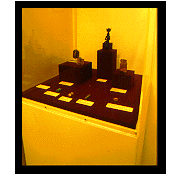![]()
 Many of the images of divine beings seen in "Gender
and Religion" are protective in some way, helping to insure the safety,
status, or afterlife of the person who wore, owned, dedicated, or even saw
the image. As in most premodern societies, life in ancient Egypt was a precarious
endeavor for everyone: life spans were short, mortality rates in childbirth
and infancy were high, and the natural environment bore frequent threats
of flood, famine, and dangerous animals. To counteract these dangers, the
ancient Egyptians developed strategies involving protective images, amulets,
and the use of magic. Many of these strategies involved the invocation of
female deities who were known for protective powers; goddesses such as Isis
and Hathor were specialists in specific protective functions. Women and
their children were especially at risk at certain points of life, and their
protection was seen as a particular priority. Given the state of Egyptian
medical knowledge, childbirth was a time of special danger for both mother
and newborn, while children remained vulnerable to disease and their environment
as they grew up. A whole complex of protective strategies involving specialized
goddesses and gods developed to ensure the safety of women and children.
Protection was a gendered activity in Egyptian thought, specific in terms
of both protective deities and protected entities.
Many of the images of divine beings seen in "Gender
and Religion" are protective in some way, helping to insure the safety,
status, or afterlife of the person who wore, owned, dedicated, or even saw
the image. As in most premodern societies, life in ancient Egypt was a precarious
endeavor for everyone: life spans were short, mortality rates in childbirth
and infancy were high, and the natural environment bore frequent threats
of flood, famine, and dangerous animals. To counteract these dangers, the
ancient Egyptians developed strategies involving protective images, amulets,
and the use of magic. Many of these strategies involved the invocation of
female deities who were known for protective powers; goddesses such as Isis
and Hathor were specialists in specific protective functions. Women and
their children were especially at risk at certain points of life, and their
protection was seen as a particular priority. Given the state of Egyptian
medical knowledge, childbirth was a time of special danger for both mother
and newborn, while children remained vulnerable to disease and their environment
as they grew up. A whole complex of protective strategies involving specialized
goddesses and gods developed to ensure the safety of women and children.
Protection was a gendered activity in Egyptian thought, specific in terms
of both protective deities and protected entities.
![]()